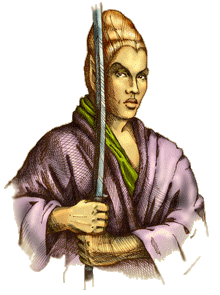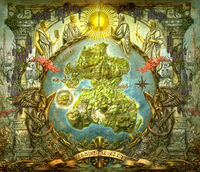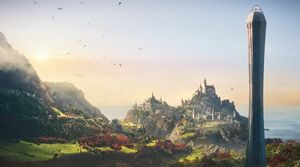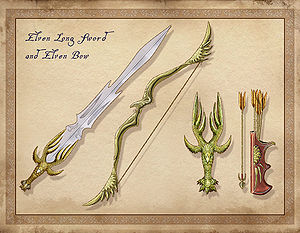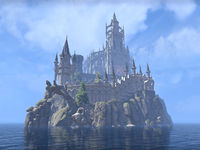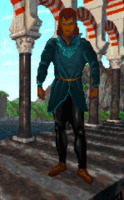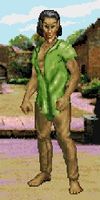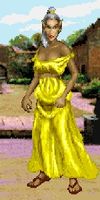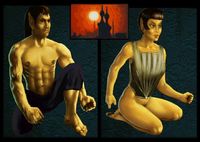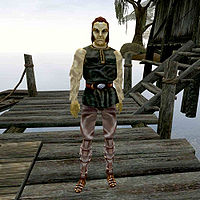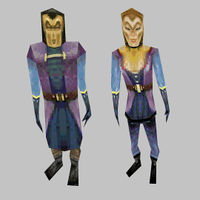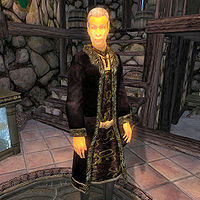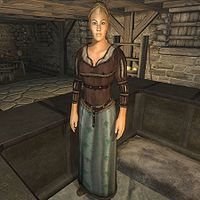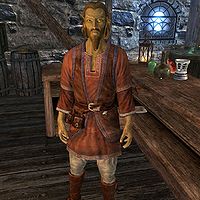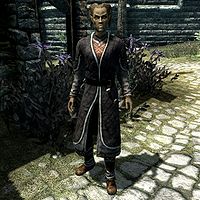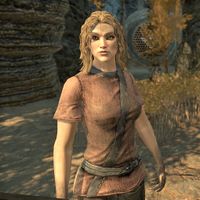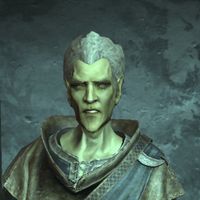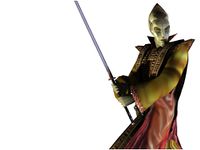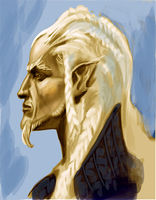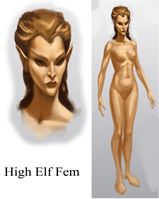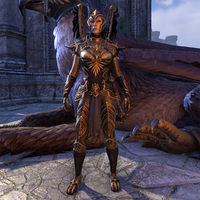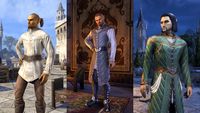Lore:Altmer
The Altmer, also known as High Elves by the denizens of Tamriel,[1] by the archaic term Salache,[2] or as the self-titled "Cultured People", are a tall, golden-skinned elven race hailing from the Summerset Isles. They are among the longest-living races of Tamriel and are regarded as being one of the most intelligent,[3] often becoming highly powerful magic users thanks to their innate magical affinity.[4]
The Altmer are considered the most gifted in the arcane arts of all races, possessing strong resistance to disease and immunity to paralysis.[5] However, they are also somewhat vulnerable to elemental forces such as fire, frost, and shock, making them weak against their own greatest strength—magic.[6] Altmer possess a natural lifespan ranging from several centuries up to a thousand years, though few ever reach this upper limit due to external factors.[7][8] Some of the most ancient and powerful Altmer mages have extended their lives far beyond this natural span, in some cases enduring for several thousands of years through the use of potent magical practices.[9][10]
High Elves are often perceived by other races as proud, sometimes even arrogant or snobbish.[11] The Altmer, for their part, consider themselves Tamriel’s most civilized people; the continent’s common tongue is derived from Altmer speech and writing, and much of the Empire’s art, craftsmanship, law, and scientific knowledge can trace its roots back to Altmer traditions.[12][13]
Contents
Appearance[edit]
The Altmer are typically relatively tall, often standing a full head taller than the average men or mer.[14] They possess slender, graceful builds with long limbs and refined features,[15] and their skin tones are typically various shades of gold—a trait that commonly sets them apart from most other elven races.[14] Their hair is usually fair—blond, ginger, white, or silver—though darker shades such as brown or black are also fairly common.[16] Eye colors range from blue, green, and brown to gold and amber, often described as luminous or piercing.[17] Their facial features are angular, with high cheekbones, narrow chins, and long, sharply pointed ears.[18] In both posture and expression, Altmer often project an air of superiority or aloofness, reinforced by their cultural upbringing.[15]
Altmer fashion reflects their fixation with beauty, status, and arcane mastery. Their garments are typically ornate, made of fine silks and enchanted fabrics, and adorned with motifs of the sun, stars, and arcane symbols.[19] Jewelry and personal grooming are highly valued, and signs of very advanced aging are rarely visible—thanks to both natural longevity and magical upkeep.[20][21]
History[edit]
Origins and Early Schisms[edit]
Altmer are thought to be the most direct, unaltered descendants of the original Aldmer elves,[12] and the transition from one to the other is not very clear. The Altmer seemed to have changed by staying the same. When the Aldmer left their home island of Aldmeris, most if not all of them settled first in the Summerset Isle.[12][22] Much of their history is lost or hidden, but it is known that many unique ruins and structures, notably the Ceporah Tower, predate the Aldmeri arrival by at least several hundred years.[12] They likely warred with the Sload of Thras and other strange, unknown creatures for control of Summerset in ancient times.[12][23] At some point they came together and formed the Crystal Tower as a monument to the spirit of their race, and it was the pinnacle of magical learning until the construction of the Arcane University.[12]
Social clashes among the Aldmer would lead to a series of emigrations from Summerset Isle to regions all over Tamriel, notably under the prophet Veloth, which would lead to the great diversification of Elven races, such as the Chimer, Bosmer, Orsimer and Ayleids (exactly when and where the Dwemer and Snow Elves emerged is not clear, but they are believed to all have a common ancestry).[12][24][25][26] Many different, often corroborating legends claim that the changes of each race were the result of differences in their worship of deities.[24][27][28][29][30][31] The Maormer, or Sea Elves, of Pyandonea were at one time counted among these emigrant groups from Summerset, but tapestries in the Crystal Tower suggest that their divergence from the Aldmer took place before the Elves had quit Aldmeris – an account that had been accepted by both Altmer and Maormer sources by the middle Second Era.[32][33][34]
The Direnni Hegemony and the Expansion in Northwest Tamriel[edit]
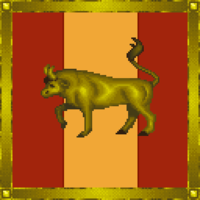
One clan of Altmer, the Direnni, established a foothold in High Rock and rose to power there in the early First Era, founding the Direnni Hegemony. Strengthened by Ayleids fleeing the ascendant Alessian Order in Cyrodiil,[35] at its height the Hegemony incorporated parts of Skyrim and Hammerfell.[36] The number of Direnni Altmer was always small, and in High Rock the Altmer interbred with local Nedes, producing the Manmeri race who would later be known as the Bretons.[37][38] The Bretons assumed positions as stewards and administrators under the Hegemony,[37] and though the Direnni defeated an Alessian invasion at the climactic Battle of Glenumbra Moors in 1E 482,[35] they were so weakened in the victory that the emergent Breton nobility were able to force them to retreat from almost the whole of High Rock to the Isle of Balfiera – the site of the primordial Tower of Ada-mantia, which became known as the Direnni Tower.[37] The Direnni continued to rule Balfiera long afterwards as Castellans until the Warp in the West in 3E 417,[38][39] and retained a reputation as powerful mages, defeating a Redguard invasion of the isle in 1E 907.[37] Their clan stronghold in Summerset itself, however, had fallen into ruin by the middle of the Second Era.[40]
Colonies of Altmer existed in other parts of western Tamriel during the First Era, though these proved more short-lived. The Corelanya Clan established a foothold on the coasts of Hammerfell in the 6th century of the First Era, taking over the formerly Ayleid city of Salas En, and possibly participated in a larger Bosmeri trade network.[41] Said to be Daedra-worshippers, they were driven out and killed in 1E 853 by invading Ra Gada forces from Yokuda under the leadership of King Xakhwan.[42]
The Aldmeri Dominions and Imperial Rule[edit]
While mainland Tamriel experienced many problems and sagas during the First and early Second Era, the sea insulated the Altmer of Summerset from their problems, though they had their own limited internal conflicts as well as repeated, large-scale invasions from the Sload and Maormer to deal with.[12] In 2E 580,[43] however, amid the chaos of the Interregnum that followed the fall of the Second Empire, Queen Ayrenn of Summerset allied with the Bosmer of Valenwood and the Khajiit of Elsweyr in the Elden Accord to form the First Aldmeri Dominion.[44] The Dominion's propaganda decried the carelessness of Men and promoted the establishment of Elven rule across Tamriel, viewing the Aldmeri races as the only peoples with the "wisdom and restraint" to be its proper stewards. To that end, the Dominion fought the Three Banners War against the Daggerfall Covenant and Ebonheart Pact for control of mainland Tamriel.[45] The war's ultimate outcome is unknown, but all three alliances, as well as the Empire of Cyrodiil, had ceased to exist by the ninth century of the Second Era.
A Second Dominion was established in 2E 830 following Altmer intervention in a dynastic dispute in Valenwood. The Second Dominion once again allied the Altmer with the Bosmer and Khajiit, but also with the Maormer — their hereditary enemies, who claim that the Altmer are a mongrel race and that the Sea Elves (Maormer) are the true descendants of the “purest strain” of Aldmeri ancestors, though this claim is highly dubious.[33][46] This expanded alliance could not stand against Tiber Septim, who crushed the Dominion with the help of the Numidium and finally brought the Summerset Isle into the Imperial fold in 2E 896.[47][48] The Altmer remembered the conquest with shame and horror, and likely contributed to social unrest among their youth later in the Third Era.[12] The Maormer, for their part, resumed hostilities in the 3E 110, attacking and threatening to conquer Summerset in the War of the Isle. The Altmer, already under the Empire, had to accept the assistance from the Septim Third Empire in order to repel the invasion.[12] The united alliance of the kings of Summerset and Antiochus Septim,[48] combining the Imperial fleet and the royal navies of Summerset Isle, together with the magical powers of the Psijic Order, succeeded in destroying the Pyandonean invading fleet.[49]
Rise of the Thalmor and the Great War[edit]
The Oblivion Crisis of 3E 433 proved an even more traumatic moment for the Altmer. As Daedra overran Tamriel, the unnatural turmoil of the seas killed many of the Altmer fleeing the mainland to Summerset, and wrecked the ports that would have received them. The Crystal Tower briefly served as a stronghold for the surviving refugees in Summerset until it fell to powerful Daedric forces.[50] A group named the Thalmor, originally an obscure bureau for the preservation of Altmeri heritage, had played an important role in the governments of the First and Second Dominions.[51][46] Following the chaos of the Crisis, an extremist cabal of Altmer supremacists now assumed this name and claimed credit for saving the Altmer from extinction using "deep and subtle magicks".[52] In 4E 22, the re-formed Thalmor seized power in Summerset outright and deposed the Altmer monarch, renaming the province Alinor.[53][54] Soon afterwards, in 4E 29, a faction friendly to the Thalmor took over Valenwood and formed a new union with the Altmer, establishing the Third Aldmeri Dominion.[53]
The Third Dominion proceeded to break off all contact with the Empire, and the Altmer lands remained silent to the outside world for some seventy years as the Thalmor consolidated their power.[53] A grim demonstration of the ruthlessness of the Thalmor in this pursuit – and the continuing resistance to their rule among some Altmer – was the Night of Green Fire in 4E 42, in which a group of Altmer dissidents were massacred by Thalmor mages at Sentinel.[55] At any rate, the Thalmor's sway continued to expand. After Nirn's moons vanished in the Void Nights of 4E 98–100, they claimed credit for their restoration and persuaded the Khajiit of Elsweyr to ally once more with the Aldmeri Dominion in 4E 115. Finally, the Thalmor turned their sights on the Empire itself. From 4E 171 to 175 the Dominion fought the Great War against the Empire, inflicting a series of punishing defeats that led to the signing of the White-Gold Concordat, which ceded large parts of southern Hammerfell to the Dominion, disbanded the Blades, and banned the worship of the man-god Talos across the Empire.[53]
With the entire province of Hammerfell having gained independence from the Empire, and the Empire itself in turmoil from a civil war in Skyrim – abetted by the Thalmor and the possible assassination of Emperor Titus Mede II[56][57] – the Altmer had attained a position of substantial power in Tamriel by 4E 201, though much remained unclear about the situation in Alinor itself.
Religion and Cosmology[edit]
The religious worldview of the Altmer is deeply rooted in their belief that they are the direct descendants of the Aedra, or "ancestor spirits"—divine beings who gave their essence to shape the mortal world.[58][59] According to Altmeri myth, the cosmos began before the Dawn Era, when the primordial force Anu, representing stasis and order, brought forth Anuiel, the soul of all things. Anuiel then created Sithis, the personification of change and limitation, so that it might know itself.[60] The interplay of Anuiel and Sithis gave rise to the Aurbis, the chaotic void in which the Original Spirits-that would come to be known as Aedra and Daedra—emerged.[58]
The Altmer interpret the creation of the Mundus as a cosmic catastrophe initiated by Lorkhan, the "Trickster God," who persuaded some spirits to participate in creating a flawed, mortal plane. This act is seen as a spiritual fall from the divine to the temporal, severing the Elves from their ancestral eternity.[61] The emergence of the elves is described in the Altmeri creation myth, according to which some of the Aedra that stayed to work on Nirn after Magnus departed, known also as the Ehlnofey,[UOL 1][62] chose to have offspring. The ensuing offspring grew progressively weaker than their parents with each generation, a phenomenon of generational diminishment that soon led to the emergence of the first Aldmer.[58] Auri-El, the chief deity of the Altmeri pantheon and the soul of Anuiel, from whom most modern Altmer claim direct descent, is said to have opposed Lorkhan, led the faithful Aedra against him, and eventually ascended to Aetherius, becoming a model of apotheosis for his followers.[61][63]
Over time, social stratification influenced religious practice. The lower classes increasingly adopted the ancestor spirits claimed by their social superiors over their own, contributing to the consolidation of a more centralized pantheon, comprised of figures such as Auri-El, Trinimac, Syrabane, and Phynaster, who were among those ancestor spirits that came to be considered gods. A shift in religion opposed by some of the Aldmeri elders, who broke off to form the Psijic Order in protest.[12] Despite this convergence, debates persist over which beings are truly worthy of veneration, and dissenters—especially those sympathetic to Men or heterodox figures like Lorkhan—are often marginalized or persecuted.[53] Altmer view themselves as "true children of the Et'Ada", descendants of the Aedric Divines in an unbroken line dating back to Nirn's creation, a divine lineage which is thought to allow them to achieve Apotheosis in certain circumstances.[64][65][66] The ultimate spiritual aspiration of the Altmer is thus to transcend mortality and return to the divine state of their ancestors, following the example of Auri-El and the Aedra. In this, their religion serves not only as a cultural anchor but as a metaphysical roadmap back to the stars.[63]
The principal Altmeri pantheon consists of Auri-El, Magnus, Trinimac, Y’ffre (also called Jephre), Xarxes, Mara, Stendarr, and Syrabane.[67] Additional cults also revere deities such as Phynaster and, controversially, Lorkhan.[67] However, limitations to eight or nine deities are considered an Imperial imposition and are generally rejected by traditionalist Altmer.[12] Sacred numbers in Altmeri numerology include three, five, and eight, each reflecting metaphysical ideals of harmony and balance.[68] The Altmer view their gods as parts of a "divine body", often articulated in religious teachings as follows: the Hand of Auri-El, Eye of Magnus, Arm of Trinimac, Bones of Y’ffre, Mouth of Xarxes, and Heart of Mara. Altmer theology holds that through devotion, they remain spiritually united with these divine aspects.[69] Among these deities, Xarxes holds particular importance as the god of memory, record-keeping, and genealogy. Believed to have been either Auri-El’s divine scribe since the beginning of time, or a mortal priest who ascended to divinity, he now maintains an eternal archive of every Altmer life.[66][70] He is also credited with authoring the Aldmeriad, the Elven origin epic, and instructing the Altmer to create Oghmas—everscriven scrolls that memorialize their lives as sacred duty in honor of their inherited divine spark.[64]
Altmeri religious authority is governed by a priestly hierarchy. Aldarchs lead monastic communities dedicated to peace and meditation,[71] while temple priests instruct acolytes and officiate public rites.[69] Ascendant Curates manage the conferral, refinement, and ceremonial destruction of calians—talismanic tokens bestowed upon young Altmer at the age of majority, signifying their entrance into adult society.[72][73]
Stendarr is a controversial figure in Altmeri religion. Some venerate him for his compassion and burden-bearing, while others denounce him as a god of Men, unworthy of worship.[74][75] The popular hymn Praise Be originally included a verse extolling Stendarr, which was omitted in later written versions—suggesting a rift in doctrinal acceptance.[76] Daedra worship is officially outlawed and culturally taboo, though some Altmer—particularly those drawn to power and arcane mastery—form clandestine cults to the Daedric Princes.[77][78] Civil authorities prosecute these practices harshly, and the living gods of the Tribunal Temple are viewed as seditious heresies.[79] Some Altmer are venerated posthumously as saints, such as Saint Ohmandil and Saint Terilde. Their relics, including the Circlet of Saint Ohmandil and Saint Terilde's Fingerbone, are preserved and honored in temples and monasteries.[80][81][82]
With the coming of the Third Empire, many Altmer resented the apotheosis of Talos, bitterly recalling Tiber Septim’s brutal conquest of the Summerset Isles.[54] However, large-scale religious controversy did not erupt until the Thalmor seized power in the early Fourth Era. The Thalmor declared that no human like Tiber Septim, could achieve godhood,[83] and outlawed the worship of Talos within their territories.[54] In the lead-up to the Great War, the ban on Talos worship was formalized as one of the Aldmeri Dominion’s demands to the Empire—demands largely seen as a pretext for an invasion that was already planned.[84] Emperor Titus Mede II conceded to the ban in the White-Gold Concordat, a peace treaty that ended the conflict.[85] Afterward, incidents such as the Markarth Incident saw the Thalmor demand the right to enforce the ban on Talos worship within Imperial territory, claiming the authority to uphold the treaty—despite using it to justify further espionage and suppression in preparation for renewed conflict.[86][87]
Philosophy and the Path to Alaxon[edit]
One of the most enduring philosophical doctrines in Altmeri society is the Path to Alaxon, a tradition that frames life itself as a progressive striving toward perfection—both spiritual and physical. Alaxon is not a place, but a transcendent state of being, a conceptual endpoint of refinement in thought, form, and behavior. Altmer believe that the closer they come to Alaxon, the closer they return to the divine nature of their Aldmeri ancestors.[88]
The Path to Alaxon is not universally codified, but it is widely understood to require discipline, ritual, ancestral merit, and internal adherence to praxis—a system of customs and behaviors that structure Altmer social and moral life.[89] Mer who demonstrate advancement along this path may be awarded an Alaxon Sphere, a polished aetherquartz crystal granted by religious or civic authorities in recognition of their perceived refinement. Like calians, these may be ritually destroyed if the bearer is found to have violated core Altmeri principles.[90] The pursuit of perfection shapes nearly every aspect of Altmeri life. It is reflected in clothing, etiquette, naming conventions, education, and even urban planning. In architecture, Alaxon manifests through iterative refinement: each generation of builders builds upon the aesthetics and techniques of the last, subtly advancing toward a more ideal expression.[UOL 2] The cities of Summerset are designed with perfection in mind. Urban layouts are often symmetrical and feature numerologically significant alignments, such as triple gateways, septenary towers, or mirrored staircases. The most famous architectural embodiment of this principle is the Crystal tower, a structure described as embodying every lesson ever learned by the Altmer.[54]
The College of Sapiarchs, one of the most prestigious intellectual institution in Summerset, educates its members not only in magical theory and history but in the correct philosophical understanding of praxis and perfection.[91] The College maintains and interprets the Scrolls of Praxis, a body of ceremonial precedent that serves both legal and moral functions in Altmeri society.[92] The Sapiarchs' Labyrinth, a complex through which heirs to the Altmeri throne must study for exactly 3,555 days, is a direct expression of this philosophy: prolonged ritual education is necessary not just for rulership, but for self-refinement.[91]
The Divine Prosecution, a judicial body operating under the guidance of the Thalmor and Sapiarchs, enforces law not merely to maintain civic harmony, but to preserve the moral clarity of society.[93] Justiciars and jurisreeves assess violations of praxis as deviations from the path to perfection, and their judgments can include not only exile or punishment, but symbolic acts such as the breaking of a calian or Alaxon Sphere.[94] Even among Altmeri dissidents and reformers, the Path to Alaxon retains a powerful cultural pull. Debates often center not on whether perfection should be pursued, but how it should be pursued—and by whom.[95][96]
Culture[edit]
Social Structure and Hierarchy[edit]
At the time the Crystal Tower was built in the Merethic Era, the Elves of Summerset had a relatively egalitarian society, though social stratification slowly developed into a rigid hierarchy of classes over the millennia.[12] The Wise (teachers and priests) became the highest echelon, followed by Artists, Princes, Warriors, Landowners, Merchants, Workers, and enslaved peoples such as Goblins.[12] Early literature by man painted the High Elves in poor light, though the impartiality of these accounts is questionable. It was suggested that the Altmer practiced eugenic infanticide, putting to death nine in ten of their newborns due to impurities, that Altmeri names are simply combinations of numbers in their own language, and that Altmer culture revolves around displaying social status.[46] Some of this has basis in fact; Altmer born with deformities or impurities are often – though not always[UOL 3] – abandoned by their parents as "hulkynd" (sometimes to be raised by priests of Stendarr),[97] and the full name of an Altmer is relatively extensive, detailing their patrilineal and matrilineal histories in addition to the history of their clan.[98]
Praxis[edit]
At an Altmer's coming of age, they are granted a calian, a sphere of aetherquartz crystal representing their honor and social status.[89][99] The aetherquartz in calian spheres is polished using ground pumice and ocean sand.[100] Calians are considered to be "praxic talismans".[101] Mer who have committed some particularly grievous crime against Altmer law are termed "ousters" and "apraxics". While ousters are simply banished from their homes,[102] apraxics are treated more severely: their calians are ceremonially shattered by a curate and it is wholly forbidden for Altmer in good standing to speak to them.[103][101] Some apraxics labor for years to restore their status, as part of which they must painstakingly repair their own calian,[89][104] while others choose to remain in exile. Nonetheless, in the middle of the Second Era subversive literature written by aprax mer gained wide currency among young Altmer on Summerset Isle,[103] and provoked some of them to engage in revolutionary activity.[101] This questioning of Altmer customs coincided with reforms introduced by Queen Ayrenn after the founding of the First Aldmeri Dominion, including the end of Summerset's longstanding isolation and the opening of its borders to other races and cultures, which provoked heated debate and political maneuvering.[105][95][96]
Law and Government[edit]
Altmer society was highly stratified by the middle of the Second Era. The monarch of Summerset ruled as sovereign with the advice of the College of Sapiarchs, an elite and highly selective scholarly institute,[91] and was sometimes represented by a viceroy titled the Proxy Queen or King.[106] The monarch descended from an almost continuous line of royalty extending back to the Merethic Era.[107] Their behavior was regulated by a set of written precedents known as the Scrolls of Praxis, whose chief interpreters were the Sapiarchs: these formed part of a broader system of inherited norms termed the Ceremoniarchy.[92][43] The heir to the throne was required to study the Ceremoniarchy for 3,555 days in the Sapiarchs' Labyrinth before they could take the crown,[91] and royal decrees were issued in its name.[105] Hereditary nobles termed kinlords and kinladies held many of the Altmer lands in fief. Altmer royalty were assisted by lieutenants titled vicereeves,[108] while cities that served as county seats were administered by canonreeves, civil officials equivalent to mayors in other cultures.[109]
The Divine Prosecution administers secular and religious justice,[93] and is made up of jurisreeves overseeing investigations and rank-and-file justiciars. Jurisreeves travel and deliberate in groups of three, each with distinct responsibilities: a revelator-naganwe to conduct magical inquiries, an admanen to serve as an inspector, and a thalmilan who would weigh the evidence and render a verdict.[110] The jurisreeves may have originated as a religious order.[111] Under Queen Ayrenn's First Aldmeri Dominion, executive responsibilities were increasingly assumed by the Thalmor, originally a bureau for the protection of Altmeri heritage.[51] The Thalmor incorporated the Divine Prosecution as a division at that time,[112] but the Prosecution existed long before the Thalmor's rise to power.[113]
The Altmer stringently regulate traffic into Summerset, and they have banned the import of such foreign goods as books, foods and perfumes in the past.[114] At the time of the First Aldmeri Dominion, the roster of forbidden books included mundane foreign writings judged to be "coarse", but the Divine Prosecution devoted particular attention to the suppression of literature promoting Daedra worship.[115]
Altmer politics was transformed in the early Fourth Era by the return of the Thalmor as a militant Elven supremacist group following the Oblivion Crisis. In the wake of the chaos caused by the Crisis and the fall of the Crystal Tower, the Thalmor overthrew the Summerset monarchy in a coup d'état.[54] Since then, officers of the Thalmor have taken direct charge of government functions such as diplomacy and espionage.[116]
Dissidence and Reform[edit]
As mentioned, whenever a substantial minority had some sort of socio-political or theological disagreement with the majority in Summerset in the Dawn Era, the dissidents would leave and usually go on to become other races of Mer. However, some time in the Merethic Era, one early group of dissidents who opposed the evolution to the traditional Altmer pantheon left the mainland of Summerset but remained quintessentially Altmer. The Psijics decided to follow the mystical Old Ways of Aldmeris and broke away to settle Artaeum, the third-largest island of the Isle.[12][48][9] Though they have often refused requests for dialogue from Alinor during their periods of seclusion from Tamriel,[117] the Psijics are not hostile to the other Altmer, and have offered their magic to protect Summerset in the past.[118] A leader of the Psijics, Ritemaster Iachesis, led them through the entire First Era and most of the Second, a span of some 3,500 years, giving some indication of the potential longevity of the Altmer.[9][119][120]
A subsequent bout of dissent occurred late in the Third Era, as younger Altmer again began pushing for social reform. These episodes were unusual in a society used to dissidents simply leaving.[12] But there were few if any places left to go at that point. Some change had taken place by the end of the Third Era: the Altmer once more allowed foreigners to come to their shores; some non-Altmer were even allowed to rise to the ranks of nobility in Summerset.[12] Many of these young rebellious Altmer turned to the Psijics for guidance, somewhat ironically consulting their distant past for a path to their future, while some militant radicals turned to terrorism.[12]
These tentative reforms were substantially reversed at the turn of the Fourth Era by the rise of the Thalmor, who instituted a policy of persecution and even open slaughter of dissidents and non-Elven races.[54] Numerous surviving Altmer dissidents were forced to flee to other parts of Tamriel, where they were frequently targeted by Thalmor assassins.[55][54] While many Altmer continue to disagree with the Thalmor in private, few venture to oppose them publicly.[121]
Fashion[edit]
Altmer fashion is influenced by the ideas of praxis and that all High Elves should appear as nobles, regardless of actual rank. Their clothing and accessories are often high end and are made to show their pride as Altmer. Silk is a common material. Canonreeves might be seen carrying silken parasols to guard from the sun's rays[122] and lace trimmed silk handkerchiefs on their person.[123] Neckerchiefs are also worn.[124] Some parasols bear minor enchantments allowing them to magically protect the area beneath and around the user from the weather.[125]
A kinlord may use fine beeswax to polish his boots.[126] Altmer in general often wear their boots overly tight so they can purposefully show off their ankles and so tend to have to use silver shoehorns to remove them.[127] A Kinlady wearing the styles of Skywatch or Firsthold may wear riding boots sporting diamond tipped silver spurs.[128] Should a high elven lady wish to swim in Summerset's pristine waters she may wear nothing more than a sensuous thong bathing suit gleaming with silver sequins.[129]
Holidays[edit]
- Feast of the Immortal Subterfuge
- A gold leaf mask mounted to a plaque may be displayed by Trinimac worshippers during this holiday.[130]
Gallery[edit]
Appearances[edit]
Miscellaneous[edit]
A Third Era Altmer
(Morrowind)
Notes[edit]
- The term "High Elf" originates in the works of J. R. R. Tolkien's legendarium.
See Also[edit]
- Altmer Names
- For a list of notable Altmer, see here.
- For game-specific information, see the Arena, Daggerfall, Battlespire, Morrowind, Shadowkey, Oblivion, Skyrim, Elder Scrolls Online, Legends, and Blades articles. Also see the Redguard category.
- High Elvish
Books[edit]
- A Case for Open Borders by Kinlord Andurion — A father's plea for his fellow Mer to open their minds
- Civility and Etiquette by Coristir — An Altmer guidebook outlining the correct social protocols when dealing with various peoples and beings
- Crafting Motif 1: High Elf Style by Doctor Alfidia Lupus — Beginning notes by Doctor Alfidia Lupus for a series of pamphlets on the major cultural styles of Tamriel
- The Great War by Legate Justianus Quintius — A soldier's summation of the major events before and during the Great War
- Guide to Altmeri Culture — An excerpt on Altmer dueling traditions
- Notes on Elven Architecture by Gastinus Florus, Masons' Guild Historian — Notes on Altmer architecture and its similarities to Ayleid design
- On the College of Sapiarchs by Adandora, Chronicler at Large — A treatise on the renowned College of Sapiarchs in Summerset
- The Price of Praxis by Ceruval Rolumaril — An Altmer recounts his life and the importance of his calian
- Protocol and Propriety in Summerset — A note outlining proper etiquette when dining with Altmer
- A Rejection of Open Borders by Kinlady Avinisse of Shimmerene — A member of the Summerset nobility explains her opposition to the Queen's Decree
- Rising Threat by Lathenil of Sunhold — A multi-volume series on the threat posed by the Thalmor
- Sages of the Crystal Tower by Nularan, Mages Guild Scribe — A Mages Guild scholar describes the renowned Sapiarchs of the Crystal Tower
References[edit]
- ^ Pocket Guide to the Empire, 1st Edition: Prologue — Imperial Geographical Society, 2E 864
- ^ The Wild Elves — Kiergo Chorvak
- ^ Race Description of Altmer in Legends
- ^ High Elf racial abilities in Arena
- ^ High Elf racial abilities in Daggerfall
- ^ High Elf racial abilities in Morrowind and Oblivion
- ^ Ask Us Anything: Variety Pack 4
- ^ The Real Barenziah, v 2
- ^ a b c Fragment: On Artaeum — Taurce il-Anselma, 3E 400
- ^ Psijic Mascot Bear Cub pet description in ESO
- ^ Notes on Elven Architecture — Gastinus Florus, Masons' Guild Historian
- ^ a b c d e f g h i j k l m n o p q r Pocket Guide to the Empire, 3rd Edition: The Blessed Isle: Alinor and the Summersets — Imperial Geographical Society, 3E 432
- ^ Antecedants of Dwemer Law
- ^ a b Pocket Guide to the Empire, 1st Edition: Aldmeri Dominion — Imperial Geographical Society, 2E 864
- ^ a b Pocket Guide to the Empire, 3rd Edition: The Blessed Isle: Alinor and the Summersets — Imperial Geographical Society, 3E 432
- ^ High Elf character creation options in ESO
- ^ Altmer card artwork and flavor text in The Elder Scrolls: Legends
- ^ Race artwork in Arena and Daggerfall
- ^ Crafting Motif 9: Altmer Style in ESO
- ^ Varieties of Faith in the Empire
- ^ The Real Barenziah, v 2
- ^ Pocket Guide to the Empire, 3rd Edition: All the Eras of Man, A Comprehensive History of our History — Imperial Geographical Society, 3E 432
- ^ Pocket Guide to the Empire, 3rd Edition: Other Lands — Imperial Geographical Society, 3E 432
- ^ a b The Changed Ones
- ^ Pocket Guide to the Empire, 3rd Edition: The Throat of the World: Skyrim — Imperial Geographical Society, 3E 432
- ^ A Short History of Morrowind — Jeanette Sitte
- ^ The True Nature of Orcs
- ^ The Anticipations — Anonymous
- ^ Vivec and Mephala
- ^ Father Of The Niben — Florin Jaliil
- ^ The House of Troubles
- ^ The Maormer of Pyandonea — Imperial Geographical Society
- ^ a b The Chosen People of Aldmeris — Sealord Malleroth Of Pyandonea
- ^ The False Revanchism of the Maormer — Hadendril of Skywatch
- ^ a b The Last King of the Ayleids — Herminia Cinna
- ^ The Daggerfall Chronicles — Ronald Wartow
- ^ a b c d The Bretons: Mongrels or Paragons? — Phrastus of Elinhir
- ^ a b Pocket Guide to the Empire, 1st Edition: High Rock — Imperial Geographical Society, 2E 864
- ^ The Warp in the West — Ulvius Tero
- ^ Events of Lauriel's Lament in ESO: Summerset
- ^ The Salas En Expedition — Lady Clarisse Laurent
- ^ Prince Haqmir's dialogue in ESO
- ^ a b Ayrenn: The Unforeseen Queen — Headmaster Tanion of the College of Aldmeri Propriety
- ^ Queen Ayrenn's dialogue in ESO
- ^ Welcome to New Aldmeri Irregulars — Aicantar of Shimmerene, Sapiarch of Indoctrination
- ^ a b c Pocket Guide to the Empire, 1st Edition: Aldmeri Dominion — Imperial Geographical Society, 2E 864
- ^ On Morrowind — Erramanwe of Sunhold
- ^ a b c Brief History of the Empire v 1 — Stronach k'Thojj III
- ^ The Wolf Queen, v5 — Waughin Jarth
- ^ Rising Threat, Vol. I — Lathenil of Sunhold
- ^ a b Aicantar of Shimmerene Answers Your Questions — Aicantar of Shimmerene
- ^ Rising Threat, Vol. II — Lathenil of Sunhold
- ^ a b c d e The Great War — Legate Justianus Quintius
- ^ a b c d e f g Rising Threat, Vol. IV — Lathenil of Sunhold
- ^ a b Legate Fasendil's dialogue in Skyrim
- ^ Thalmor Dossier: Ulfric Stormcloak
- ^ Events of To Kill an Empire in Skyrim
- ^ a b c The Monomyth
- ^ Aedra and Daedra
- ^ Sithis
- ^ a b Varieties of Faith... — Brother Mikhael Karkuxor of the Imperial College
- ^ The Mystery of Artaeum — Penewen, Advisor to the Court
- ^ a b Vairabrian's dialogue in ESO
- ^ a b The Onus of the Oghma — Phrastus of Elinhir
- ^ Ayrenn: The Unforeseen Queen — Headmaster Tanion of the College of Aldmeri Propriety
- ^ a b Tu'whacca, Arkay, Xarxes — Lady Cinnabar of Taneth
- ^ a b Varieties of Faith: The High Elves — Brother Mikhael Karkuxor of the Imperial College
- ^ Thoughts on the Sacred Numbers
- ^ a b Uurkar of Auri-El's dialogue in ESO
- ^ Words and Power — Telenger the Artificer
- ^ Monastic Firinore's dialogue in ESO
- ^ The Price of Praxis — Ceruval Rolumaril
- ^ Aetherquartz Prayer Beads codex entry in ESO
- ^ Rituals of the Harmonious Masters — Aritanwe of Lillandril
- ^ Transcription of Praise Be
- ^ Praise Be
- ^ Dialogue from ON:Seeker Duperil and ON:Seeker Veraye in ESO
- ^ The Banished Cells loading screen in ESO
- ^ ON:Sotha Sil's dialogue in ESO
- ^ Circlet of Saint Ohmandil item description in Online:ESO
- ^ Saint Terilde's Fingerbone item description in Online:ESO
- ^ Monastic Nenaron's dialogue in Online:ESO
- ^ Ondolemar's dialogue in Skyrim
- ^ Events of Skyrim:Diplomatic Immunity in Skyrim
- ^ Dialogue and documents in White-Gold Concordat
- ^ Events of Markarth Incident
- ^ Dialogue and Thalmor dossiers in Skyrim
- ^ Olnewil's dialogue in ESO: Summerset
- ^ a b c The Price of Praxis — Ceruval Rolumaril
- ^ Cases of the Divine Prosecution — High Magistrate Rinwaray, Bureaureeve of the Divine Prosecution
- ^ a b c d On the College of Sapiarchs — Adandora, Chronicler at Large
- ^ a b Sages of the Crystal Tower — Nularan, Mages Guild Scribe
- ^ a b The Divine Prosecution — Axulfa Giant-Slayer, Nord Cultural Exchange
- ^ Cases of the Divine Prosecution — High Magistrate Rinwaray, Bureaureeve of the Divine Prosecution
- ^ a b A Case for Open Borders — Kinlord Andurion
- ^ a b A Rejection of Open Borders — Kinlady Avinisse of Shimmerene
- ^ Manacar's dialogue in ESO
- ^ Lirendel's Family Shrine
- ^ Aquiline Calian Sphere codex entry in ESO
- ^ Aetherquartz Prayer Beads codex entries in ESO
- ^ a b c Dialogue of the Mother of Rats in ESO: Summerset
- ^ Azarari's dialogue in ESO
- ^ a b Lanarie's dialogue in ESO: Summerset
- ^ Apraxic Decanter codex entries in ESO
- ^ a b An End to Isolation — Queen Ayrenn
- ^ Valsirenn's dialogue in ESO: Summerset
- ^ Alinor Royal Palace loading screen in ESO: Summerset
- ^ Vicereeve Pelidil's dialogue in ESO
- ^ Canonreeve Elquisa's dialogue in ESO: Summerset
- ^ Jurisreeve Lorne's dialogue in ESO: Summerset
- ^ Jurisreeve's Eye codex entries in ESO
- ^ Chief Justiciar Carawen's dialogue in ESO: Summerset
- ^ Please Respond, Your Beloved Aunt Daiyanni — Kinlady Daiyanni
- ^ Renzir's dialogue in ESO: Summerset
- ^ Justiciar Tanorian's dialogue in ESO: Summerset
- ^ Events of Diplomatic Immunity in Skyrim
- ^ The Mystery of Artaeum — Penewen, Advisor to the Court
- ^ Events of The Tower Sentinels in ESO: Summerset
- ^ 2920, The Last Year of the First Era — Carlovac Townway
- ^ Events of Lost in Translation in ESO: Summerset
- ^ Telarendil's dialogue in Blades
- ^ Canonreeve's Silken Parasol item description in ESO
- ^ Canonreeve's Silken Handkerchiefs item description in ESO
- ^ Summerset Silk Neckerchief item description in ESO
- ^ Clement Climate Picnic Parasol item description in ESO
- ^ Archon's Hive Boot Polish item description in ESO
- ^ Silver Shoehorn item description in ESO
- ^ High Kinlady's Diamond-Tipped Spurs item description in ESO
- ^ Swan-Satin Bathing Thong item description in ESO
- ^ Gold-Leaf Trinimac Worship-Plaque item description in ESO
Note: The following references are considered to be unofficial sources. They are included to round off this article and may not be authoritative or conclusive.
| |||||||||||||||||||||||||||||||||||||||||||
